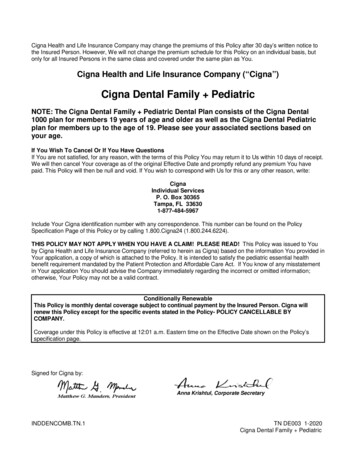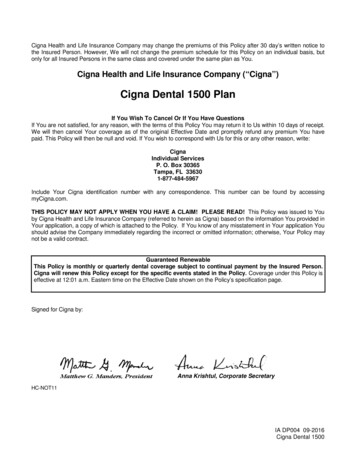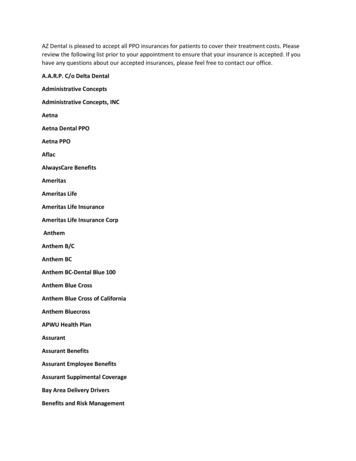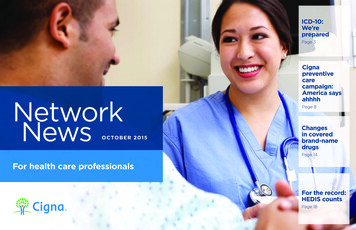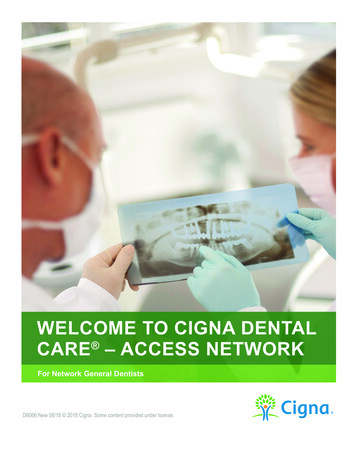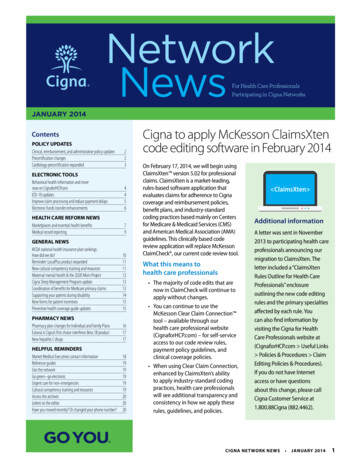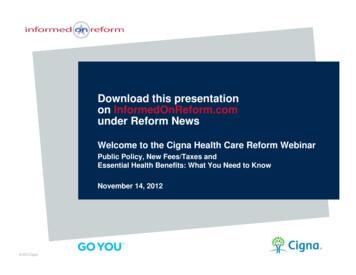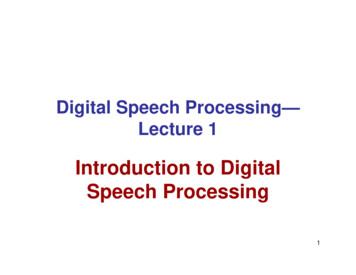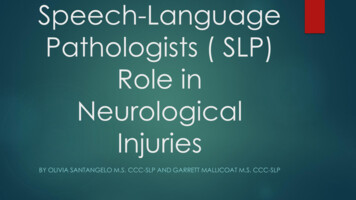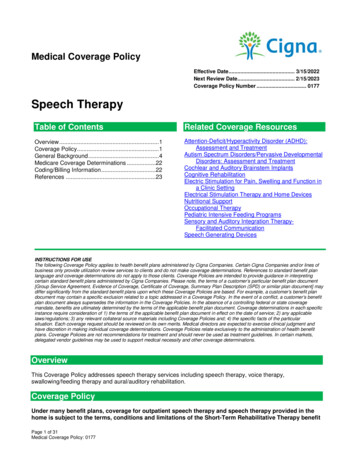
Transcription
Medical Coverage PolicyEffective Date . 3/15/2022Next Review Date. 2/15/2023Coverage Policy Number . 0177Speech TherapyTable of ContentsRelated Coverage ResourcesOverview . 1Coverage Policy.1General Background .4Medicare Coverage Determinations .22Coding/Billing Information .22References .23Attention-Deficit/Hyperactivity Disorder (ADHD):Assessment and TreatmentAutism Spectrum Disorders/Pervasive DevelopmentalDisorders: Assessment and TreatmentCochlear and Auditory Brainstem ImplantsCognitive RehabilitationElectric Stimulation for Pain, Swelling and Function ina Clinic SettingElectrical Stimulation Therapy and Home DevicesNutritional SupportOccupational TherapyPediatric Intensive Feeding ProgramsSensory and Auditory Integration TherapyFacilitated CommunicationSpeech Generating DevicesINSTRUCTIONS FOR USEThe following Coverage Policy applies to health benefit plans administered by Cigna Companies. Certain Cigna Companies and/or lines ofbusiness only provide utilization review services to clients and do not make coverage determinations. References to standard benefit planlanguage and coverage determinations do not apply to those clients. Coverage Policies are intended to provide guidance in interpretingcertain standard benefit plans administered by Cigna Companies. Please note, the terms of a customer’s particular benefit plan document[Group Service Agreement, Evidence of Coverage, Certificate of Coverage, Summary Plan Description (SPD) or similar plan document] maydiffer significantly from the standard benefit plans upon which these Coverage Policies are based. For example, a customer’s benefit plandocument may contain a specific exclusion related to a topic addressed in a Coverage Policy. In the event of a conflict, a customer’s benefitplan document always supersedes the information in the Coverage Policies. In the absence of a controlling federal or state coveragemandate, benefits are ultimately determined by the terms of the applicable benefit plan document. Coverage determinations in each specificinstance require consideration of 1) the terms of the applicable benefit plan document in effect on the date of service; 2) any applicablelaws/regulations; 3) any relevant collateral source materials including Coverage Policies and; 4) the specific facts of the particularsituation. Each coverage request should be reviewed on its own merits. Medical directors are expected to exercise clinical judgment andhave discretion in making individual coverage determinations. Coverage Policies relate exclusively to the administration of health benefitplans. Coverage Policies are not recommendations for treatment and should never be used as treatment guidelines. In certain markets,delegated vendor guidelines may be used to support medical necessity and other coverage determinations.OverviewThis Coverage Policy addresses speech therapy services including speech therapy, voice therapy,swallowing/feeding therapy and aural/auditory rehabilitation.Coverage PolicyUnder many benefit plans, coverage for outpatient speech therapy and speech therapy provided in thehome is subject to the terms, conditions and limitations of the Short-Term Rehabilitative Therapy benefitPage 1 of 31Medical Coverage Policy: 0177
as described in the applicable benefit plan’s schedule of copayments. Swallowing/feeding therapy isconsidered a form of speech therapy.Outpatient speech therapy is the most medically appropriate setting for these services unless theindividual independently meets coverage criteria for a different level of care.Coverage for speech therapy varies across plans. Refer to the customer’s benefit plan document forcoverage details.If coverage is available for speech therapy, the following conditions of coverage apply.Speech/Language TherapyA prescribed course of speech therapy for the treatment of a speech/language impairment (CPT codes92507, 92508) or for the use of a speech-generating device (CPT code 92609) is considered medicallynecessary when ALL of the following criteria is met: When accompanied by an evaluation completed within the last 12 months by a certified speechlanguage pathologist that includes age-appropriate standardized tests or measures that quantify theextent of language/speech impairment, performance deviation, or pragmatic skill deficits.The therapy plan includes quantifiable, attainable short- and long-term treatment goals against whichprogress will be documented.The treatment being recommended has the support of a treating licensed healthcare provider (e.g.,referral, prescription).The therapy being ordered requires either one-to-one intervention or group setting with supervision by aspeech-language pathologist.The therapy is individualized, and meaningful improvement is expected from the therapy.Continuation of speech therapy visits is considered medically necessary when ALL of the followingcriteria are met: There is documented quantifiable improvement towards established short and long-term treatmentgoals.Functional progress is being made.Generalization and carryover of targeted skills into natural environment is occurring.Goals of therapy are not yet met.Individual is actively participating in treatment sessions.Voice TherapyA prescribed course of voice therapy is considered medically necessary when provided by a certifiedspeech-language pathologist for a significant voice disorder associated with the laryngeal structuresthat are associated with anatomic abnormality, neurological condition, injury (e.g., vocal nodules orpolyps, vocal cord paresis or paralysis, paradoxical vocal cord motion) or provided after vocal cordsurgery when ALL of the following criteria are met: The treatment being recommended has the support of a licensed healthcare provider (e.g., referral,prescription).The therapy being ordered requires the one-to-one intervention and supervision of a speech-languagepathologist. The therapy plan includes quantifiable, attainable short- and long-term treatment goals against which progress willbe documented. The therapy is individualized, and meaningful improvement is expected from the therapy.Page 2 of 31Medical Coverage Policy: 0177
Continuation of voice therapy is considered medically necessary, as indicated by ALL of the following: Functional progress is being madeGeneralization and carryover of targeted skills into natural environment is occurringGoals of therapy are not yet metIndividual is actively participating in treatment sessionsAuditory/Aural RehabilitationAuditory/aural rehabilitation (CPT code 92630, 92633) is considered medically necessary for thetreatment of a hearing impairment that is the result of trauma, tumor or disease, or followingimplantation of a cochlear or auditory brainstem device when ALL of the following criteria are met: The treatment being recommended has the support of a treating licensed healthcare provider (e.g.,referral, prescription).An evaluation has been completed by a certified speech-language pathologist or licensed audiologistthat includes standardized speech and/or hearing tests.The therapy plan includes quantifiable, attainable short- and long-term treatment goals against whichprogress will be documented.The therapy being ordered requires the one-to-one intervention and supervision of a speech-languagepathologist or audiologist.The therapy is individualized, and meaningful improvement is expected from the therapy.Swallowing/Feeding TherapySwallowing/feeding therapy is considered medically necessary for individuals with swallowing andchildren with a feeding disorder when ALL of the following criteria are met: The swallowing or feeding disorder is the result of an underlying medical condition.The medical necessity of the therapy has been demonstrated by results of testing with avideofluorographic swallowing study (VFSS) or other appropriate testing in combination with anevaluation by a certified speech-language pathologist.The therapy plan includes quantifiable, attainable short- and long-term treatment goals against whichprogress will be documented.The treatment includes a transition from one-to-one supervision to an individual or caregiver providedmaintenance level on discharge.Not Medically NecessaryThe following are considered not medically necessary: speech therapy services for developmental speech or language delays/disorders one standard deviation(SD) or less below the mean in the areas of receptive, expressive, pragmatic or total languagecomposite scoreany computer-based learning program for speech or voice training purposes unless used for utilization ofan approved speech generating devicespeech therapy services that are educational learning services such as reading, writing, and spellingwithout evidence of a documented spoken language disorderschool speech programsspeech, voice therapy, auditory/aural rehabilitation or swallowing/feeding therapy that duplicatesservices already being provided as part of an authorized therapy program through another therapydiscipline or speech therapy (e.g., occupational therapy; audiologic services)maintenance programs of routine, repetitive drills/exercises that do not require the skills of a speechlanguage therapist and that can be reinforced by the individual or caregiverPage 3 of 31Medical Coverage Policy: 0177
vocational rehabilitation programs and any programs with the primary goal of returning an individual toworkmaintenance or preventive treatment provided to prevent recurrence or to maintain the patient’s currentstatustherapy or treatment intended to improve or maintain general physical conditiontherapy or treatment provided to improve or enhance job, school or recreational performance, includingintensive educational programs even if provided by a speech therapistlong-term rehabilitative services when significant therapeutic improvement is not expected (e.g., whenthere is therapeutic plateau)swallowing/feeding therapy for food aversionsvoice therapy in the absence of an anatomic laryngeal abnormality (e.g., functional dysphonia,spasmodic dysphonia)auditory/aural rehabilitation for presbycusisElectrical stimulation for swallowing/feeding disorders is considered experimental, investigational orunproven.General BackgroundSpeech and Language ImpairmentsAphasiaApraxia of speech (AOS) Childhood Apraxia of Speech Acquired Apraxia of SpeechSpeech Sound Disorders: Articulation and PhonologyFluency DisorderContinuation of Speech TherapyGroup TherapyDuplication of ServicesSpeech-Language PathologistSpeech Therapy—Speech Generating Device (CPT code 92609)Auditory/Aural RehabilitationPresbycusisAutism Spectrum Disorders (ASD)/Pervasive Developmental Disorders (PDD)Voice TherapyVelopharyngeal InsufficiencyTherapy for Swallowing and Feeding DisordersElectrical Stimulation for DysphagiaSpeech Software and Computer-Based ProgramsEducational Services (Including Intensive Educational Programs)Appendix: Documentation Requirements for Speech TherapySpeech-language pathology services are considered necessary for the diagnosis and treatment of swallowing(dysphagia), speech-language, and cognitive-communication disorders that result in communication disabilities.Speech-language pathologists treat disorders of speech sound production (e.g., articulation, apraxia, dysarthria),resonance (e.g., hypernasality, hyponasality), voice (e.g., phonation quality, pitch, respiration), fluency (e.g.,stuttering), language (e.g., comprehension, expression, pragmatics, semantics, syntax), cognition (e.g.,attention, memory, problem solving, executive functioning), and feeding and swallowing (e.g., oral, pharyngeal,and esophageal stages).(ASHA, 2015).A communication disorder is an impairment in the ability to receive, send, process, and comprehend concepts ofverbal, nonverbal, and graphic symbol systems. A communication disorder may be evident in the processes ofhearing, language, and/or speech. A communication disorder may range in severity from mild to profound. It maybe congenital or acquired. Individuals may demonstrate one or any combination of communication disorders. APage 4 of 31Medical Coverage Policy: 0177
communication disorder may result in a primary disability or it may be secondary to other disabilities (ASHA,2015).A speech disorder is an impairment of the articulation of speech sounds, fluency and/or voice: An articulation disorder is the atypical production of speech sounds characterized by substitutions,omissions, additions or distortions that may interfere with intelligibility. A fluency disorder is an interruption in the flow of speaking characterized by atypical rate, rhythm, andrepetitions in sounds, syllables, words, and phrases. This may be accompanied by excessive tension,struggle behavior, and secondary mannerisms. A voice disorder is characterized by the abnormal production and/or absences of vocal quality, pitch,loudness, resonance, and/or duration, which is inappropriate for an individual's age and/or sexA language disorder is impaired comprehension and/or use of spoken, written and/or other symbol systems. Thedisorder may involve the form of language (phonology, morphology, syntax), the content of language(semantics), and/or the function of language in communication (pragmatics) in any combination.The Center for Disease Control and Prevention (CDC), National Center for Health Statistics, data from theNational Health Interview Survey of Communication Disorders and Use of Intervention Services Among ChildrenAged 3–17 Years (Black, et al., 2015) includes the findings for communication disorders: Nearly 8% of children aged 3–17 years had a communication disorder during the past 12 months. Children aged 3–6 years, boys, and non-Hispanic black children were more likely than other children tohave had any communication disorder. Approximately 55% of children aged 3–17 years who had any communication disorder received anintervention service during the past 12 months. Among those with any communication disorder, younger children, boys, and non-Hispanic white childrenwere more likely than other children to receive an intervention service for their disorder.Speech and Language ImpairmentsApraxia of speech (AOS)Apraxia of speech (AOS) is a neurologic speech disorder that reflects an impaired capacity to plan or programsensorimotor commands necessary for directing movements that result in phonetically and prosodically normalspeech. AOS has also been referred to in the clinical literature as verbal apraxia or dyspraxia.Apraxia Pediatrics (Childhood Apraxia of Speech)This is also referred to as: Articulatory dyspraxia Childhood verbal apraxia Developmental apraxia of speech Developmental verbal apraxia Developmental dyspraxia Developmental verbal dyspraxia Motor planning difficultiesChildhood apraxia of speech (CAS) is a nervous system disorder, which impacts an individual’s ability tovoluntarily plan, select, execute or sequence the motor patterns necessary to produce sounds, syllables or words(ASHA-l).Currently, there are no validated diagnostic features that differentiate CAS from other childhood speech sounddisorders. However, three segmental and suprasegmental features consistent with a deficit in the planning andprogramming of movements for speech have gained some consensus among those investigating CAS: Inconsistent errors on consonants and vowels in repeated productions of syllables or words. Lengthened and disrupted coarticulatory transitions between sounds and syllables. Inappropriate prosody, especially in the realization of lexical or phrasal stress.Page 5 of 31Medical Coverage Policy: 0177
Assessment is accomplished using a variety of standardized and nonstandardized measures andactivities. Comprehensive assessment for speech sound disorders typically includes a case history, oralmechanism examination, speech sound assessment, and language assessments, if indicated. A keyconsideration in the motor speech assessment is an evaluation of movement accuracy. Using a variety of tasks,the SLP looks for the presence of consensus features and other clinical characteristics of CAS to help identifythe presence of motor-based planning and speech difficulties.A comprehensive oral mechanism examination includes a motor speech assessment. This is important fordifferentiating CAS from childhood dysarthria and other speech sound disorders and for identifying both oralapraxia and apraxia of speech which may occur in the absence of the other.Assessment should include performance across multiple contexts (e.g., spontaneous vs. elicited vs. imitatedutterances), as results can vary by context. Fluidity (smoothness), rate, consistency, lexical stress, and accuracyshould be monitored, as there may be trade-offs among these variables (e.g., the child's productions might besmoother when speaking rate is slow vs. rapid).Dynamic assessment is important for differential diagnosis of CAS and for determining severity and prognosis.Using dynamic assessment procedures, the clinician can provide cues (e.g., gestural or tactile cues) to betterjudge the child's speech production and to determine how much cueing is necessary to facilitate performance.Assessments and Measurement Tools: Kaufman Speech Praxis Test for Children (KSPT) Verbal Motor Production Assessment for Children (VMPAC) The Apraxia Profile Screening Test for Developmental Apraxia of Speech-2 (STDAS-2)Treatment goals for children with CAS focus on facilitating overall communication and language skills mayinclude: increasing speech production and intelligibility when indicated, using AAC, such as gestures, manual signs, voice output devices, and context-specificcommunication boardsIt is recommended that to the extent possible, treatment takes place in naturalistic environments, is provided in aculturally appropriate manner, and involves as many important people in the child's life as possible to facilitatecarryover and generalization of skills. Involving caregivers in treatment helps them understand and practicegoals with the child outside the treatment setting.Many children with CAS also have phonological impairment and language impairment. The relative contributionof motoric and linguistic deficits is considered when planning treatment. If a child has mild motoric deficits andsignificant phonological deficits, then linguistic approaches may need to be prioritized while also bringing in someprinciples of motor learning to facilitate movement accuracy.Treatment approaches that focus directly on improving speech production can be classified: Motor programming approaches—use motor learning principles, including the need for many repetitionsof speech movements to help the child acquire skills to accurately, consistently, and automatically makesounds and sequences of sounds. Linguistic approaches—focus on CAS as a language learning disorder; these approaches teach childrenhow to make speech sounds and the rules for when speech sounds and sound sequences are used in alanguage. Combination approaches—use both motor programming and linguistic approaches. Rhythmic (prosodic) approaches, such as melodic intonation therapy, use intonation patterns (melody,rhythm, and stress) to improve functional speech production.Acquired Apraxia of SpeechApraxia, dyspraxia- related terms include:Page 6 of 31Medical Coverage Policy: 0177
Conduction aphasiaIdeomotor apraxiaBroca's aphasiaOral or verbal apraxiaPhonemic paraphasiaApraxia of speech (AOS) is defined as “a neurologic speech disorder that reflects an impaired capacity to plan orprogram sensorimotor commands necessary for directing movements that result in phonetically and prosodicallynormal speech” (ASHA[k]). The severity of AOS varies greatly from sound distortions and hesitant, gropingspeech to the total inability to produce any sound on a volitional basis (ASHA-k).AOS is caused by any process or condition that compromises the structures and pathways of the brainresponsible for planning and programming motor movements for speech. Causes most often include: stroke traumatic brain injury (TBI) tumor surgical trauma (e.g., tumor resection) progressive diseaseTreatment can be restorative (i.e., aimed at improving or restoring impaired function) and/or compensatory (i.e.,aimed at compensating for deficits not amenable to retraining). In the case of progressive AOS, it may also helpmaintain speech functioning. Approaches aimed at improving speech production and intelligibility focus onreestablishing motor plans/programs and improving the ability to select and activate them and set programparameters (e.g., speed) in specific situations. These treatment approaches include articulatory–kinematicapproaches, sensory cueing, rate and/or rhythm control, and various combinations thereof.Approaches used to compensate for AOS focus on teaching use of strategies or external aids and creating orpersonalizing those resources (e.g., using gestures, writing, or drawing to communicate). Some approaches maybe used in both restorative and compensatory capacities.AphasiaAphasia is an acquired neurogenic language disorder resulting from an injury to the brain, usually, the lefthemisphere. Aphasia involves varying degrees of impairment. Depending on an individual’s unique set ofsymptoms, impairments may result in loss of ability to use functional communication skills. A person with aphasiaoften has relatively intact nonlinguistic cognitive skills. Symptoms may not fit neatly into a single aphasia type, and classification may change over time ascommunication improves with recovery. The outcome of aphasia varies significantly from person to person and is determined by the initialseverity level, lesion site and size, patient age, gender and education level, patient motivation intreatment, comorbidities, and the amount of spontaneous recovery that occurs over time.Aphasia is an acquired neurogenic language disorder resulting from an injury to the brain—most typically, the lefthemisphere. Aphasia involves varying degrees of impairment in four primary areas: Spoken language expression Spoken language comprehension Written expression Reading comprehensionAssessments and Measurement Tools: Stroke and Aphasia Quality of Life Scale (SAQOL) - Spanish version available as well Western Aphasia Battery-Revised (WAB-R) Boston Diagnostic Aphasia Examination Third Edition (BDAE-3) Communication Abilities in Daily Living-3 (CADL-3) American Speech and Hearing Association Functional Assessment of Communication Skills –Revised (ASHA FACS) Communication Effectiveness Index (CETI)Page 7 of 31Medical Coverage Policy: 0177
The Stroke Impact Scale (SIS)Bedside Evaluation Screening Test-2 (BEST-2)Mississippi Aphasia Screening Test (MAST)Multilingual Aphasia Examination 3rd Edition (MAE-3)The Frenchay Aphasia Screening Test (FAST)ASHAs Person-Centered Aphasia EvaluationDocumentation Requirements: A description of the current level of functioning or impairment The most recent standardized evaluation scores, percent of functional delay, or standard deviation (SD)score, when appropriate, for the diagnosis/disability Treatment plan with functional and measurable goals including objective measures for baseline andcurrent progress/level Caregiver program or home maintenance program plan, as applicable for long term needsPresentation Aphasia Aphasia is caused by damage to the language centers of the brain. Damage may involve both the rightand left hemispheres. One of the most common causes of aphasia is stroke/CVA. Other causes includeTraumatic Brain Injury (TBI), Brain Tumor, Brain Infection, and Progressive Neurological Diseases Aphasia may be masked by the motor speech disorders of apraxia and/or dysarthria Severity ranges vary, deficits may affect one, multiple, or all areas of language functioning Dysphagia may be a co-morbidity. Cognitive impairments may negatively impact recovery of language skillsTreatment can be restorative (i.e., aimed at improving or restoring impaired function) and/or compensatory (i.e.,aimed at compensating for deficits not amenable to retraining). Specific treatment protocols will vary, based oneach individual's unique language profile and communication needs. The ultimate goal of treatment is tomaximize quality of life and communication success, using the approach or combination of approaches that bestmeets the individual's needs.Speech Sound Disorders: Articulation and PhonologyRelated terms: Speech sound disorders, Articulation disorders, Phonological processing disorders, IntelligibilitySpeech sound disorders is an umbrella term referring to any difficulty or combination of difficulties withperception, motor production, or phonological representation of speech sounds and speech segments—includingphonotactic rules governing permissible speech sound sequences in a language. Speech sound disorders canbe organic or functional in nature. Organic speech sound disorders result from an underlying motor/neurological,structural, or sensory/perceptual cause. Functional speech sound disorders are idiopathic—they have no knowncause (ASHA-m).Speech sound disorders are identified on a continuum from mild or very severe. The symptoms range in number,intensity and level of severity. More severe disorders will have a greater functional effect on the individual'sspeech intelligibility.Assessments and Measurement Tools: Kaufman Speech Praxis Test for Children (KSPT) Moving Across Syllables Goldman-Fristoe Test of Articulation-3 (GFTA-3) Fisher-Logemann Test of Articulation Competence Clinical Assessment of Articulation and Phonology-2 (CAAP-2) Spanish Preschool Articulation Test Arizona Articulation and Phonology Scale-4 (Arizona-4) Hodson Assessment of Phonological Patterns-3 (HAPP-3) Bilingual Articulation and Phonological Assessment (BAPA)Page 8 of 31Medical Coverage Policy: 0177
Photo Articulation Test-3 (PAT-3)LinguiSystems Articulation Test (LAT)Signs and symptoms of functional speech sound disorders include the following (ASHA-m): omissions/deletions—certain sounds are omitted or deleted (e.g., "cu" for "cup" and "poon" for "spoon")substitutions—one or more sounds are substituted, which may result in loss of phonemic contrast (e.g.,"thing" for "sing" and "wabbit" for "rabbit")additions—one or more extra sounds are added or inserted into a word (e.g., "buhlack" for "black")distortions—sounds are altered or changed (e.g., a lateral "s")syllable-level errors—weak syllables are deleted (e.g., "tephone" for "telephone")It is often difficult to differentiate between articulation and phonological errors or to differentially diagnose thesetwo separate disorders. Articulation error types and phonological error types may be referred to within the broaddiagnostic category of speech sound disorders. A single child might show both error types, and those specificerrors might need different treatment approaches. Historically, treatments that focus on motor production ofspeech sounds are called articulation approaches; treatments that focus on the linguistic aspects of speechproduction are called phonological/language-based approaches (ASHA-m).Articulation approaches target each sound deviation and are often selected by the clinician when the child'serrors are assumed to be motor based; the aim is correct production of the target sounds.Phonological/language-based approaches target a group of sounds with similar error patterns, although theactual treatment of exemplars of the error pattern may target individual sounds. Phonological approaches areoften selected in an effort to help the child internalize phonological rules and generalize these rules to othersounds within the pattern (e.g., final consonant deletion, cluster reduction). Articulation andphonological/language-based approaches might both be used in therapy with the same individual at differenttimes or for different reasons. Both approaches for the treatment of speech sound disorders typically involve thefollowing sequence of steps: Establishment—eliciting target sounds and stabilizing production on a voluntary level. Generalization—facilitating carry-over of sound productions at increasingly challenging levels (e.g.,syllables, words, phrases/sentences, conversational speaking). Maintenance—stabilizing target sound production and making it more automatic; encouraging selfmonitoring of speech and self-correction of errors.Fluency DisorderRelated terms: Fluency disorder Disfluency Stuttering Cluttering Dysfluency StammeringA fluency disorder is an interruption in the flow of speaking characterized by atypical rate, rhythm, anddisfluencies (e.g., repetitions of sounds, syllables, words, and phrases; sound prolongations; and blocks), whichmay also be accompanied by excessive tension, speaking avoidance, struggle behaviors, and secondarymannerisms (ASHA-o).Stuttering, the most common fluency disorder, is an interruption in the flow of speaking characterized by specifictypes of disfluencies, including repetitions of sounds, syllables, and monosyllabic words; prolongations ofconsonants when it isn’t for emphasis; and blocks (i.e., inaudible or silent fixation or inability to initiate sounds).Cluttering, is characterized by a perceived rapid and/or irregular speech rate, atypical pauses, maze behaviors,pragmatic issues, decreased awareness of fluency problems or moments of disfluency, excessive disfluencies,Page 9 of 31Medical Coverage Policy: 0177
collapsing or omitting syllables, and language formulation issues, which result in breakdowns in speec
speech, voice therapy, auditory/aural rehabilitation or swallowing/feeding therapy that duplicates services already being provided as part of an authorized therapy program through another therapy discipline or speech therapy (e.g., occupational therapy; audiologic services)
